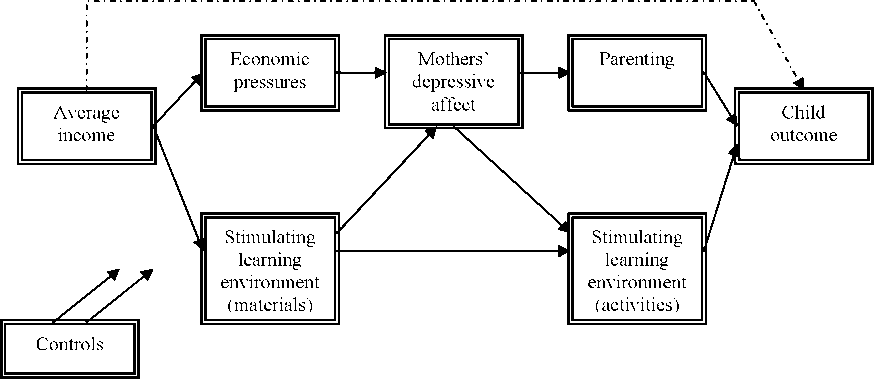More complex modelling
Box 13: Combination of human capital mediators (top) and family stress mediators
(bottom) models
??

Source: Yeung, Linver, & Brooks-Gunn, 2002, 1864
This analysis arrived at two main findings. First, as predicted, different mediating
mechanisms work for different child outcomes. Cognitively stimulating materials and
activities were the most influential mediating mechanisms for the relation between
income and children’s scores for tests on letters and words. The physical environment
of the home was the most important mediator between income and children’s applied
problems scores. In contrast, results for children’s behaviour problems operated
primarily through the mediating mechanism of maternal emotional distress. It is
interesting to note that although parental investment mediators did not have direct
effects on the child’s behaviour, having a stimulating home environment was
indirectly linked to lower behaviour problems through its association with lower
maternal distress and better parenting practices.
Secondly, effects of family income were mediated by constructs from both the
parental investment perspective and the family stress model; the explanatory power of
both models combined was greater than of either model alone. Furthermore, the
mediating constructs from the two perspectives interacted. For example, family
income was associated with maternal emotional distress and parenting practices not
only through the perception of economic pressure (family stress model) but also
through familial resources (investment model). Similarly, cognitively stimulating
homes and the physical environment of the home not only had positive effects on
children’s cognitive abilities, but were also found to relate to mothers’ psychological
well-being and warm parenting behaviour, which in turn were significantly linked to
the avoidance of behaviour problems.
78
More intriguing information
1. An Efficient Secure Multimodal Biometric Fusion Using Palmprint and Face Image2. The name is absent
3. Ultrametric Distance in Syntax
4. Chebyshev polynomial approximation to approximate partial differential equations
5. DURABLE CONSUMPTION AS A STATUS GOOD: A STUDY OF NEOCLASSICAL CASES
6. Land Police in Mozambique: Future Perspectives
7. The name is absent
8. SOCIOECONOMIC TRENDS CHANGING RURAL AMERICA
9. Self-Help Groups and Income Generation in the Informal Settlements of Nairobi
10. The name is absent